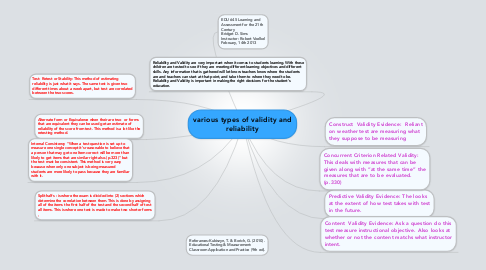various types of validity and reliability
by Bridget Sims

1. Reliability and Validity are very important when it comes to students learning. With these children are tested to see if they are meeting different learning objectives and different skills. Any information that is gathered will let know teachers know where the students are and teachers can start at that point, and take them to where they need to be. Reliability and Validity is important in making the right decisions for the student's education.
2. Test- Retest or Stability: This method of estimating reliability is just what it says. The same test is given two different times about a week apart, but test are correlated between the two scores.
3. Alternate form or Equivalence when their are two or forms that are equivalent they can be used get an estimate of reliability of the score from test. This method is a lot like the retesting method.
4. Internal Consistency “When a test question is set up to measure one single concept it’s reasonable to believe that a person that may get one Item correct will be more than likely to get items that are similar right also.(p.323)” but the test must be consistent. This method is very easy because when only one subject is being measured students are more likely to pass because they are familiar with it.
5. Split halfs : is where the exam is divided into (2) sections which determine the correlation between them. This is done by assigning all of the items the first half of the test and the second half of test all items. This is where one test is made to make two shorter forms ,
6. Referances:Kubiszyn, T. & Borich, G. (2010). Educational Testing & Measurement: Classroom Application and Practice (9th ed).
7. EDU 645 Learning and Assessment for the 21th Century Bridget D. Sims Instructor: Robert Voelkel February, 14th 2013
8. Predictive Validity Evidence: The looks at the extent of how test takes with test in the future.
9. Concurrent Criterion Related Validity: This deals with measures that can be given along with “at the same time” the measures that are to be evaluated. (p.330)
10. Construct Validity Evidence: Reliant on weather test are measuring what they suppose to be measuring
11. Content Validity Evidence: Ask a question do this test measure instructional objective. Also looks at whether or not the content matchs what instructor intent.


